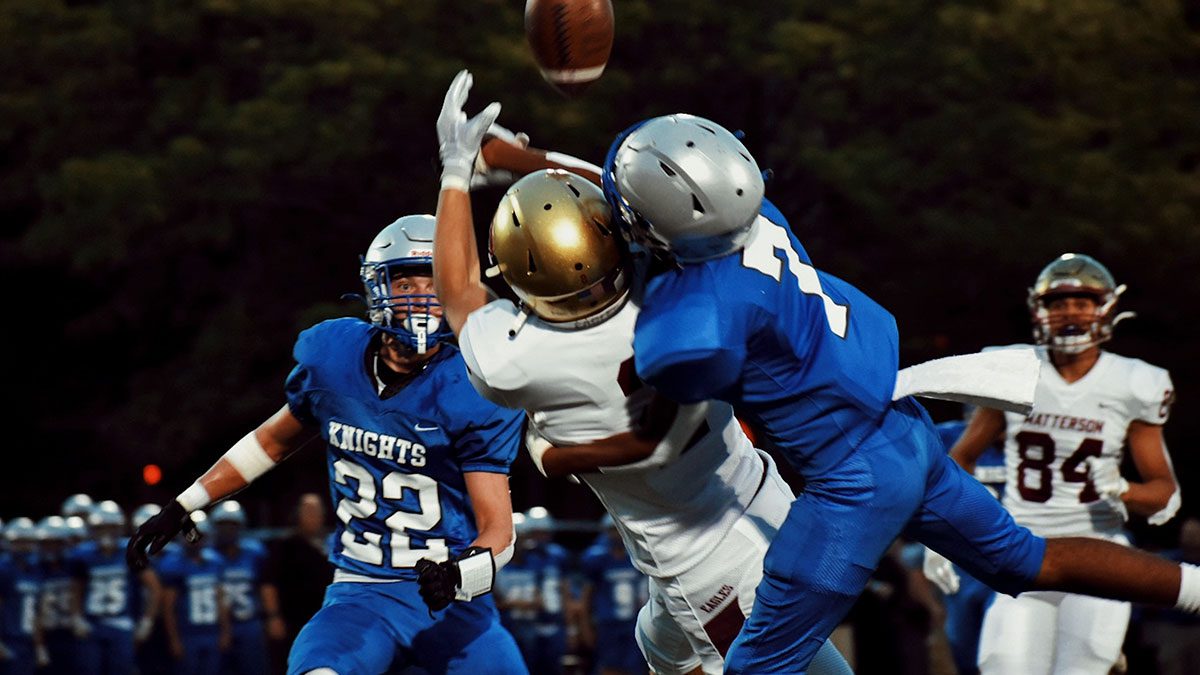In the United States the game called either football or soccer in the rest of the world is always called soccer. American football is very different. In fact, I don’t see why it should be called foot-ball at all, because the ball is not kicked around the field, as in soccer, but carried.
The ball carrier can be ‘blocked’ or ‘tackled’ by a member of the opposing team. Let’s number the players shown in the photo from left to right. No. 1 is tackling No. 2. He can grab him around any part of the body below the neck and throw him to the ground. (A change to the rules in 1976 barred ‘initial contact with the head or face while blocking and tackling.’) No. 2 is said to be ‘taking a hit.’ He may be able to hand the ball to his team mate No. 3 before he is thrown. No. 4 seems to be readying himself to tackle No. 3 if that happens.
Over 4 million boys and young men play American football each year. Of these 100,000 are college students and over a million attend high school (age 16+). The majority are even younger. Some are only 5.
Injuries are frequent. Some are fatal. According to the National Center for Catastrophic Sport Injury Research, there were 16 deaths in the 2014 season. However, I easily found half a dozen reports of football deaths of school students down to age 10 in local newspapers for the month of September 2022 alone.
The most common cause of death is severe concussion or other injury to the head or spinal cord. But death can result even from minor injuries like a gashed knee, because players ignore them and continue to play. By the time they are treated infection has set in.
It is often claimed that rule changes and protective equipment have greatly reduced the risks of the game. The effects of equipment are mixed: while it may protect the wearer, it can also harm players with whom the wearer grapples. This is especially true of plastic helmets (the earliest helmets were made of leather) and metal plates over sensitive areas like the shins.
Kathleen Bachynski has written a fascinating history of American football (No Game for Boys to Play: The History of Youth Football and the Origins of a Public Health Crisis, University of North Carolina Press 2019). Institutional football began in the late nineteenth century at elite Ivy League colleges in the northeast and at military academies. From there it spread to other colleges and after World War Two to high schools. Schools for younger children refused to organize games, but their place was taken by junior football leagues.
Football was controversial from the start. It was opposed by some physicians, theologians and mothers (the historical record rarely conveys the voices of concerned mothers directly, but contains numerous attacks on their ‘overprotective’ attitudes). In 1905 Professor Shailer Matthews of Chicago’s Divinity School urged that football be abolished: a game, he exclaimed, should ‘not require the services of a physician, the maintenance of a hospital, and the celebration of funerals.’ (Ivy League colleges hired physicians and built hospitals nearby to ensure that medical assistance would be immediately available. When the game was adopted by less wealthy schools this was no longer the case: an injured player might lie on the field for 45 minutes before an ambulance arrived.)
Supporters praised football above all as ‘a mimic battlefield’ — an ideal means of preparing boys for war as well as for the vicissitudes of life in a highly competitive society: ‘Where better could students experience the thrills of success and the agony of failure?’ The idea of football as training for war has a long pedigree: the Duke of Wellington supposedly said that ‘the Battle of Waterloo was won on the playing fields of Eton’ (the most prestigious British school for upper class boys). And even today successful high school football players are given nicknames like ‘War Daddy.’
As socialists we encourage boys to muster their moral courage, refuse to play American football, and defy any who hypocritically call them ‘sissies’ – you can go to hell with your stupid games and you can go to hell with your stupid wars!
A Note on Girls and Women in Football
Most football players (97%) are male, but some are female. The main role of girls and women in football remains cheerleading, which also causes many concussions and other injuries. I am not aware of any academic studies of the subject.



